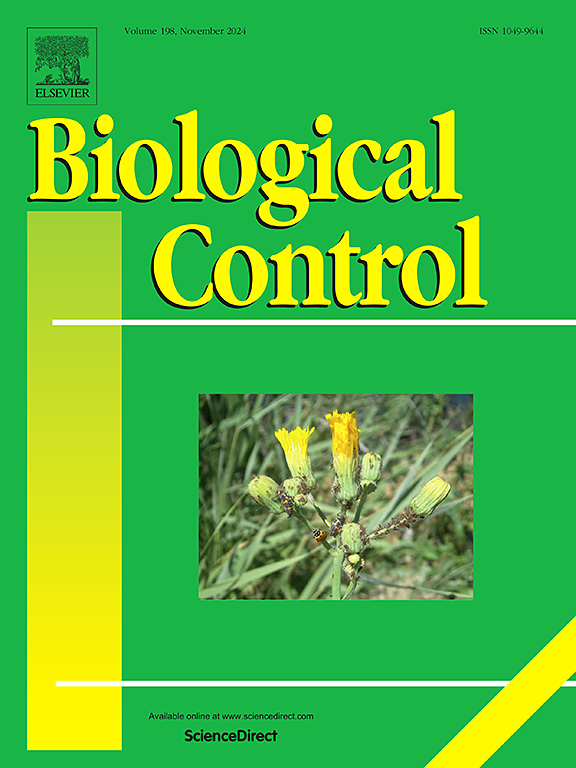Towards sustainable vector control: Innovative substrate identification for developing eco-friendly, cost-effective, and highly potent biopesticides
IF 3.4
2区 农林科学
Q2 BIOTECHNOLOGY & APPLIED MICROBIOLOGY
引用次数: 0
Abstract
The unavailability of biological insecticides for mosquitoes’ control in Tunisia and their high cost make chemical pesticides the most used solution. In the present study, the development of a bio-sourced media based on agriculture by-product and free biological material was conducted for the generation of commercially valuable biopesticide from BUPM98 Bacillus thuringiensis israelensis strain. Through the physico-chemical characterization of the spineless Opuntia ficus-indica cladodes flour (SFI flour), an important total organic carbon rate (18.92 %) was detected. Thus, SFI flour was used as a potential carbon source for B. thuringiensis cells growth and delta-endotoxin production. A bio-sourced media based on diluted sea water, SFI flour and soybean meal, was optimized for BUPM98 delta-endotoxin production through the response surface methodology. The adjusted medium improved the production by 58 % compared to the reference medium. Moreover, an additional improvement of 22.85 % in delta-endotoxin synthesis was achieved through cultivating BUPM98 in 1 L shake flasks with baffles under optimal conditions. This enabled the biopesticides production in the novel medium (FPOM-SFI) to reach 2405.5 ± 45 mg/L. Interestingly, the FPOM-SFI(BUPM98) achieved a more than threefold activity than VectoBac®12AS. In fact, it revealed LC50 values of 0.0039 mg/L and 0.0041 mg/L, against Aedes aegypti and Anophele gambiae larvae, respectively. These findings underscore the substantial potential of the BUPM98 based bio-pesticide produced in an almost bio-sourced medium for mosquito management in Tunisia as well as in North African countries, as an economical and eco-friendly alternative of chemical insecticides. FPOM-SFI(BUPM98) could be a sustainable and affordable pest control solution.

迈向可持续病媒控制:创新底物鉴定,开发生态友好、成本效益高、高效的生物农药
由于突尼斯没有生物杀虫剂来控制蚊子,而且它们的成本很高,因此化学杀虫剂是最常用的解决方案。在本研究中,以农业副产品和游离生物材料为基础,开发了一种生物源培养基,用于从BUPM98苏云金芽孢杆菌(Bacillus thuringiensis israelensis)菌株中生产具有商业价值的生物农药。通过对无刺无花果粗粉(SFI粉)的理化特性分析,检测出重要的总有机碳含量(18.92%)。因此,SFI粉可作为苏云金芽孢杆菌细胞生长和δ内毒素产生的潜在碳源。利用响应面法对以稀释海水、SFI面粉和豆粕为原料的生物源培养基进行优化,以产BUPM98 δ内毒素。调整后的培养基与参考培养基相比,产量提高了58%。此外,在最佳条件下,在1 L带挡板的摇瓶中培养BUPM98,可使δ内毒素合成提高22.85%。这使得新型培养基(FPOM-SFI)的生物农药产量达到2405.5±45 mg/L。有趣的是,FPOM-SFI(BUPM98)的活性是VectoBac®12AS的三倍以上。对埃及伊蚊和冈比亚按蚊幼虫的LC50值分别为0.0039 mg/L和0.0041 mg/L。这些发现强调了以BUPM98为基础的生物农药作为化学杀虫剂的一种经济和生态友好的替代品的巨大潜力,这种生物农药在突尼斯和北非国家几乎是生物来源的培养基中生产,用于蚊子管理。FPOM-SFI(BUPM98)可能是一种可持续和负担得起的害虫防治解决方案。
本文章由计算机程序翻译,如有差异,请以英文原文为准。
求助全文
约1分钟内获得全文
求助全文
来源期刊

Biological Control
生物-昆虫学
CiteScore
7.40
自引率
7.10%
发文量
220
审稿时长
63 days
期刊介绍:
Biological control is an environmentally sound and effective means of reducing or mitigating pests and pest effects through the use of natural enemies. The aim of Biological Control is to promote this science and technology through publication of original research articles and reviews of research and theory. The journal devotes a section to reports on biotechnologies dealing with the elucidation and use of genes or gene products for the enhancement of biological control agents.
The journal encompasses biological control of viral, microbial, nematode, insect, mite, weed, and vertebrate pests in agriculture, aquatic, forest, natural resource, stored product, and urban environments. Biological control of arthropod pests of human and domestic animals is also included. Ecological, molecular, and biotechnological approaches to the understanding of biological control are welcome.
 求助内容:
求助内容: 应助结果提醒方式:
应助结果提醒方式:


